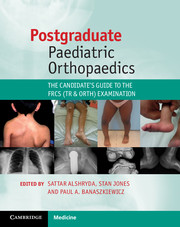Book contents
- Frontmatter
- Contents
- List of contributors
- Foreword
- Preface
- Acknowledgements
- Interactive website
- List of abbreviations
- Section 1 General guidance
- Section 2 Core structured topics
- Chapter 3 The hip
- Chapter 4 The knee
- Chapter 5 The foot and ankle
- Chapter 6 The spine
- Chapter 7 The shoulder
- Chapter 8 The elbow
- Chapter 9 Congenital hand deformities
- Chapter 10 Neuromuscular diseases
- Chapter 11 Musculoskeletal infections
- Chapter 12 Musculoskeletal tumours
- Chapter 13 Skeletal dysplasia
- Chapter 14 Metabolic bone disease
- Chapter 15 Physis and leg length discrepancy
- Chapter 16 Deformity corrections
- Chapter 17 Miscellaneous paediatric conditions
- Section 3 Exam-related material
- Index
Chapter 3 - The hip
Published online by Cambridge University Press: 05 August 2014
- Frontmatter
- Contents
- List of contributors
- Foreword
- Preface
- Acknowledgements
- Interactive website
- List of abbreviations
- Section 1 General guidance
- Section 2 Core structured topics
- Chapter 3 The hip
- Chapter 4 The knee
- Chapter 5 The foot and ankle
- Chapter 6 The spine
- Chapter 7 The shoulder
- Chapter 8 The elbow
- Chapter 9 Congenital hand deformities
- Chapter 10 Neuromuscular diseases
- Chapter 11 Musculoskeletal infections
- Chapter 12 Musculoskeletal tumours
- Chapter 13 Skeletal dysplasia
- Chapter 14 Metabolic bone disease
- Chapter 15 Physis and leg length discrepancy
- Chapter 16 Deformity corrections
- Chapter 17 Miscellaneous paediatric conditions
- Section 3 Exam-related material
- Index
Summary
Background
Although a rare condition (2:100 000), slipped upper femoral epiphysis (SUFE) is one of the most common types of paediatric and adolescent hip disorder. The incidence of SUFE varies with:
Sex: SUFE is more common in boys (75% of cases) with the peak incidence occurring at 12 to 15 years compared with 10 to 13 years in girls. Thus, boys tend to have their slip 2 years older than girls. SUFE is rarely reported after the age of 20 years [1].
Race [2]: SUFE is more common in those of African and Polynesian descent.
Laterality: SUFE is more common on the left side (as is developmental dysplasia of the hip (DDH)). The reason is unknown; it may be related to the sitting posture of right-handed children while writing. The incidence of bilaterality has been reported to be as high as 50%, although the generally accepted incidence is 20%. In children with bilateral involvement, 50–60% present with simultaneous SUFEs and those who present with a unilateral SUFE and subsequently develop a contralateral SUFE do so within 18 months. Younger patients and those with endocrine or metabolic abnormalities are at much higher risk of bilateral involvement.
Seasonal variations: this is debatable; some studies have suggested that SUFE is more common in June and July.
Aetiology
Although, the cause is poorly understood, it is believed that increased shear forces or a weak growth plate (the physis) in adolescence predisposes to SUFE. This results in the head of the femur staying in the acetabulum and the neck slipping forward and outward.
- Type
- Chapter
- Information
- Postgraduate Paediatric OrthopaedicsThe Candidate's Guide to the FRCS (Tr and Orth) Examination, pp. 17 - 61Publisher: Cambridge University PressPrint publication year: 2014



